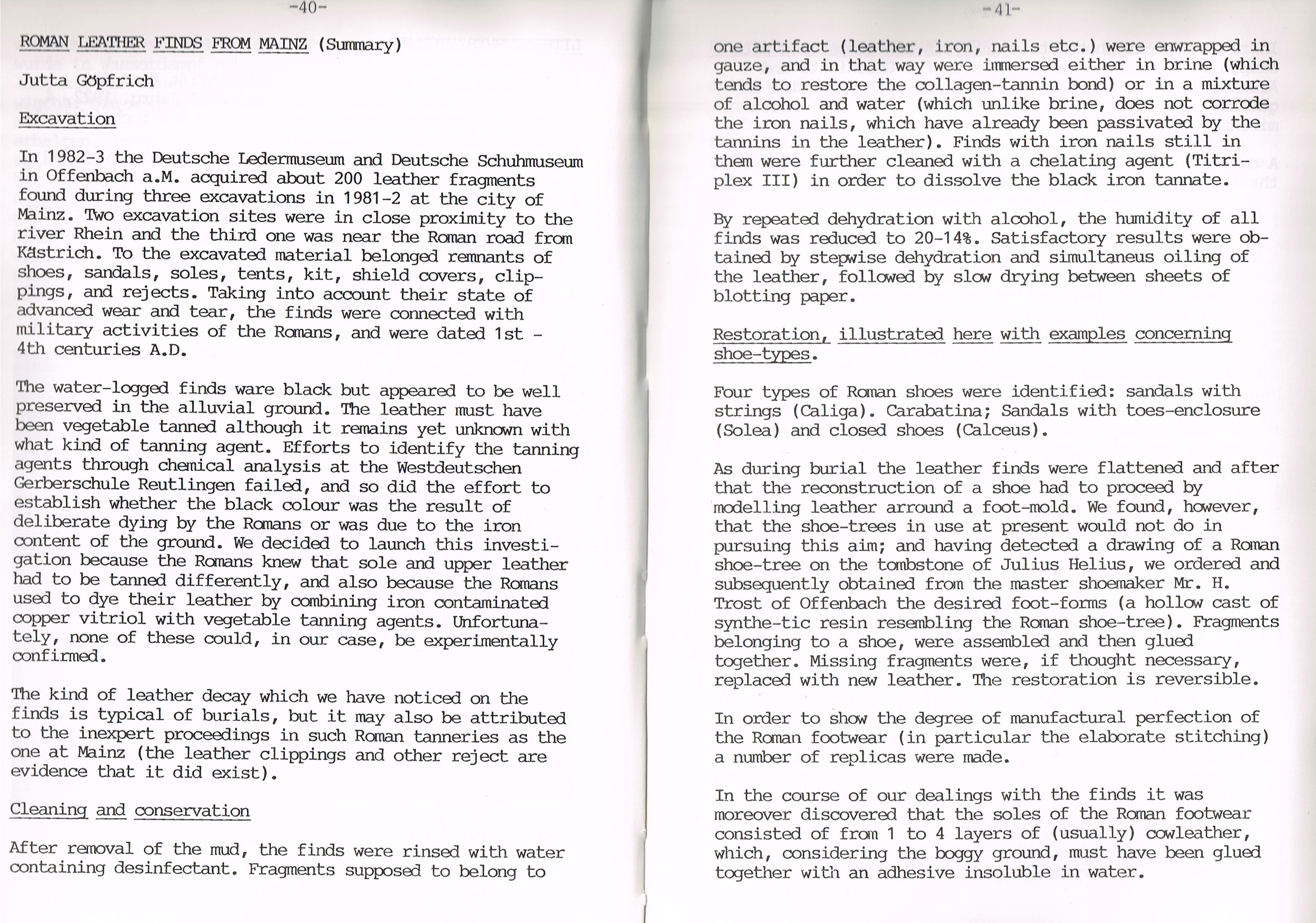CCI20140507�09

-40-
ROMAN LEATHER FINDS EROM MAINZ (Summary)
Jutta Gdpfrich
Excavation
In 1982-3 the Deutsche Ledermuseum and Deutsche Schuhmuseum in Offenbach a.M. acquired about 200 leather fragments found during three excavations in 1981-2 at the city of Mainz. Two excavation sites were in close proximity to the river Rhein and the third one was near the Roman road from Kastrich. To the excavated materiał belonged remnants of shoes, sandals, soles, tents, kit, shield covers, clip-pings, and rejects. Taking into account their state of advanced wear and tear, the finds were connected with military activities of the Romans, and were dated 1st -4th centuries A.D.
The water-logged finds ware black but appeared to be well preserved in the alluvial ground. The leather must have been vegetable tanned although it remains yet unknown with what kind of tanning agent. Efforts to identify the tanning agents through Chemical analysis at the Westdeutschen Gerberschule Reutlingen failed, and so did the effort to establish whether the black colour was the result of deliberate dying by the Romans or was due to the iron content of the ground. We decided to launch this investi-gation because the Romans knew that sole and upper leather had to be tanned differently, and also because the Romans used to dye their leather by combining iron oontaminated copper vitriol with vegetable tanning agents. Unfortuna-tely, nonę of these could, in our case, be experimentally confirmed.
The kind of leather decay which we have noticed on the finds is typical of burials, but it may also be attributed to the inexpert proceedings in such Roman tanneries as the one at Mainz (the leather clippings and other reject are evidence that it did exist).
Cleaning and conseryątion
After removal of the mud, the finds were rinsed with water containing desinfectant. Fragments supposed to belong to one artifact (leather, iron, nails etc.) were enwrapped in gauze, and in that way were immersed either in brine (which tends to restore the collagen-tarnin bond) or in a mixture of alcohol and water (which unlike brine, does not corrode the iron nails, which have already been passivated by the tannins in the leather). Finds with iron nails still in them were further cleaned with a chelating agent (Titri-plex III) in order to dissolve the black iron tannate.
By repeated dehydration with alcohol, the humidity of all finds was reduced to 20-14%. Satisfactory results were ob-tained by stepwise dehydration and simultaneus oiling of the leather, followed by siew drying between sheets of blotting paper.
Restoration, illustrated here with examples conceming shoe-types.
Four types of Ranan shoes were identified: sandals with strings (Caliga). Carabatina; Sandals with toes-enclosure (Solea) and closed shoes (Calceus).
As during burial the leather finds were flattened and after that the reconstruction of a shoe had to proceed by modelling leather arround a foot-mold. We found, hcwever, that the shoe-trees in use at present would not do in pursuing this aim; and having detected a drawing of a Roman shoe-tree on the tombstone of Julius Helius, we ordered and subseąuently obtained fran the master shoemaker Mr. H.
Trost of Offenbach the desired foot-forms (a hollcw cast of synthe-tic resin resembling the Roman shoe-tree). Fragments belonging to a shoe, were assembled and then glued together. Missing fragments were, if thought necessary, replaced with new leather. The restoration is reversible.
In order to show the degree of manufactural perfection of the Roman footwear (in particular the elaborate stitching) a number of replicas were madę.
In the course of our dealings with the finds it was moreover discovered that the soles of the Roman footwear consisted of fran 1 to 4 layers of (usually) ccwleather, which, considering the boggy ground, must have been glued together with an adhesive insoluble in water.
Wyszukiwarka
Podobne podstrony:
CCI20140507�04 - 4 - RESTORATION OF A ROMAN LEATHER HELMBT WITH EAR-MUFFS (Summary) Heinz Keller The
CCI20101229�038 40 we naprężenia ściskające, które w czasie wyciskania zraniejszaj
CCI20110406�007 - 40 - z trzech kolejnych pomiarów dla okre
40 Roman Tomaszewski W 1861 roku również w Brzegu opublikowane zostało fundamentalne dzieło Dzierżon
53428 rozdział 1 (13) 40 Roman Niestrój produktu lub miejsca zakupu), a ich efekty
CCI20120920�012 40 2-0 40 f (48 OZ&V^rcG^ (7kM) fU*sVl 2- j^&jyfcotj OtA-
CCI20131112�15 40 IIIl/i.il
SummariesElżbieta Babula Stochastic Modcling in Theory of Choicc undcr Risk The fact that neither un
40 Andrzej Bronk s. 423). Po 1945 r. nazwą religiologia posługiwali się m.in. ks. F. Manthey, ks. B.
Summary At ITeE - PIB in Radom, an ecological industrial gear oil, denoted as Arol P220, has been fo
40 Toman Pajor unlawfulncss of a pcrpctrntor’s bchaviour is of purticular rclcvancc for the dclimita
40. Środki transportu: He usually drives to work but sometimes he takes the bus. How do you travel t
Summary p240 240 CONYERSATIONAL PORTUGUESE 14. THE PLURAL 1. Nouns ending in a vowel, including na
Summary p282 282 CONYERSATIONAL PORTUGUESE 3. When the “if* clause expresses a d
więcej podobnych podstron